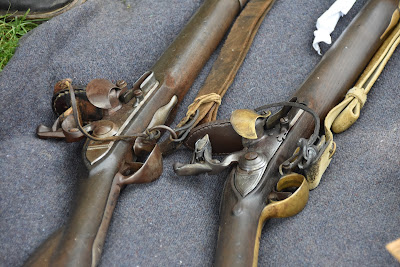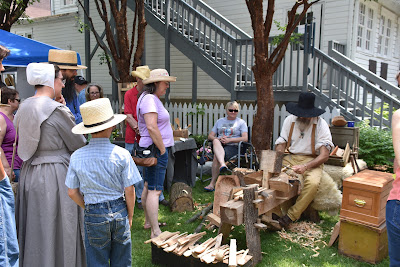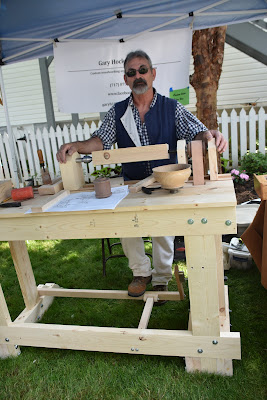 |
| The 1792 Johannes Mueller House on Main Street in Lititz, PA. |
So, that's what the members of the Historical Foundation decided to hold! And, as soon as I walked a few blocks east on Main Street after parking my car, I came upon the beautiful Johannes Mueller House. Mr. Mueller was the town dyer when he built his home on Main Street in 1742. It made the perfect place to hold the first ever Lititz Historical Festival. I walked in the main door and was greeted by a few women dressed in Colonial garb who directed me to the rear of the house where a variety of artisans told of the methods used during the American Revolutionary era. Crafts I saw included weaving, spinning, rug braiding, tin-smithing, ceramics, basketry, soap making and blacksmithing. There was even a gunsmith on hand and an authentic Conestoga Wagon in the alley behind the house. The house itself is meticulously preserved and restored and the grounds behind the home were the perfect place to hold the event. Follow along as I show you some of the artisans and tell their stories. It was another extraordinary day in the life of an ordinary guy.
 |
| The gunsmith talks about the flintlock rifle. |
 |
| A few of his weapons were on display. |
 |
| Here Gary tells me about patrons who wanted to smoke. Most would bring their bowl with them and the tavern owner would fill the pipe with tobacco. |
 |
| He also had a board similar to what would be found in a tavern. On the board were listings of notices as well as mail may be tacked to it for patrons to see and pick up. |
 |
| The wood carver was an important craftsman in a town. This fellow is making a spoon on the device he made to hold the wood. |
 |
| He could also carve bowls with a variety of chisels. |
 |
| The tin smith was an important craftsman also. Here is a candle holder made of 28 gauge tin plate. |
 |
| He demonstrated putting the edge on the candle holder. |
 |
| This gentleman made his own lathe using plans that would have been available in colonial America. A few pieces were oak with the majority of the parts made of pine. It was operated with foot power. |
 |
| A set of plans for construction of the lathe. |
 |
| The potter made bowls, mugs and pots used in the kitchen and for eating. All work was done by hand. |
 |
| Naturally, there had to be a musician. He played the entire time and I don't remember hearing the same tune more than once. Great job and he never took a break! |
 |
| The cigar maker was another important job in our new country. Everything needed for making cigars was on display. |
 |
| This device was used for cutting the end of the cigar. |
 |
| This gentleman was making woven belts. |
 |
| The results were on display. |
 |
| This young man was demonstrating blacksmithing. He would heat the metal piece in the fire on the right. |




No comments:
Post a Comment